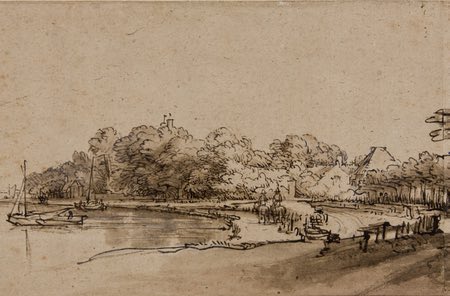[ad_1]


A bend in the River Amstel close to Kostverloren Household, Rembrandt van Rijn pen and brown ink with brown and grey washes, heightened with white bodycolour on oatmeal paper about 5 x 10″ (14 x 25 cm). First is in the collection of the Chatsworth Estate.
It would be effortless to look at a drawing like this — a sketch actually — consider it in briefly, and move on by, on the the next, much more vibrant artwork. But to me, these pen and brown ink landscape drawings by Rembrandt are between my beloved will work in the overall history of art.
Numerous of them, on additional devoted wanting, reveal them selves to me as transcendent and poetic.
Probably it is simply because I can task myself into them — even superior than with a more “realistic” painted watch — and photo myself sitting there on the bank in the shade with my possess sketchbook and pens, immersed in the day, the scent of the river, the sounds of water lapping at the boats, the light clop of the horses passing by, possibly a mild breeze waving as a result of the sunlight-topped line of trees.
Just as easily, I can photograph Rembrandt sitting down there — a sheaf of paper in his lap, reed pen and brush in his palms with probably two bottles of iron gall ink at his facet, a single whole power, a single diluted for washes — immersed in the scene and his drawing even though his troubles (of which he unquestionably had his share) recede into the distance.
As much as can be identified, these pen, brown ink and clean drawings were designed simply just for Rembrant’s personal benefit, both as practice, or (I imagine) merely for enjoyment. There is no identified link determining them as preliminary for paintings or even for any of his in the same way dealt with etchings.
Numerous of these, and other Rembrandt drawings in brown ink and clean, are detailed as drawings in bistre ink (produced from wooden-burning soot), but chemical evaluation implies that a large proportion of them may have been drawn with darker iron gall ink, generally built from oak galls, iron salts and tannic acid. I’m guessing that could be the circumstance here.
Renbrandt’s notation is breezy, economical and seemingly effortless. Just a couple of gestural lines — but brilliantly sweeping, lightly touched with tone — develop a solid line of trees, a river and its lender, boats and horsemen. Their sun bathed and shade dappled textures are developed pretty much entirely in our mind’s eye.
Mainly because it has happened to me on celebration, I have the unique emotion that drawings like this may possibly have felt to Rembrandt like they were being flowing instantly from mother nature, into his eyes, and out by way of his pen on to the paper — whilst he noticed. There is minor emotion here of artifice or the construction of a drawing as a operate of artwork.
You are not likely to see what I suggest from the compact image and depth crops I can current right here. Go to this connection and view the drawing as large in your check as you can to get the sensation I’m attempting to convey.
[ad_2]
Supply backlink